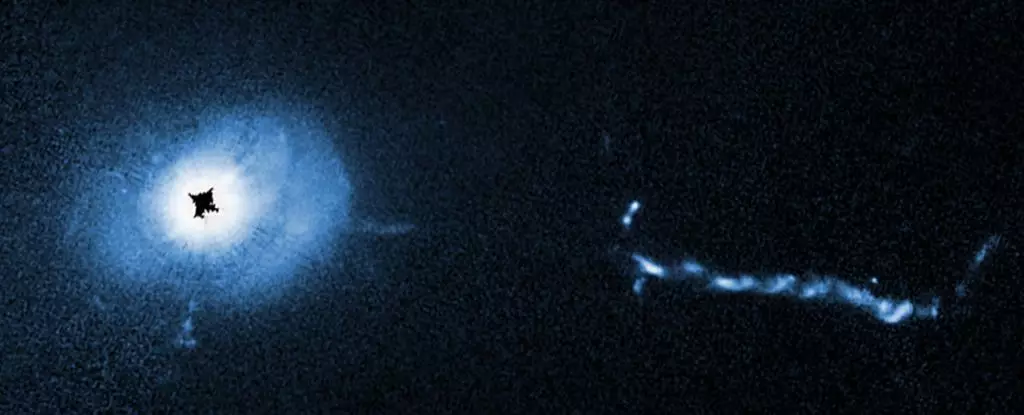The universe is filled with wonders that challenge our understanding of cosmic phenomena. One such marvel is the quasar, a luminous object powered by supermassive black holes at the center of distant galaxies. Recently, astronomers have turned their gaze toward an extraordinary target, 3C 273, which resides approximately 2.5 billion light-years away from Earth. This quasar stands out not only for its remarkable brightness but also for being one of the closest quasars known. Utilizing the powerful Hubble Space Telescope, researchers have achieved an unprecedented close-up of this celestial object, unveiling intricate structures that enhance our understanding of quasars and the mechanisms that drive their brilliance.
Quasars are often regarded as some of the most luminous entities in the cosmos—outshining even the more transient gamma-ray bursts and supernovae. Their brightness is due primarily to the supermassive black holes at their cores, which, contrary to what one might expect, do not emit visible light by themselves. Instead, they feed on surrounding gas and dust which spiral into the black hole, forming an accretion disk. The friction and gravitational forces at play within this disk generate immense heat, and as a result, particles are aglow with light across the entire electromagnetic spectrum. This glowing material signifies a dynamic cosmic process: the last vestige of energy before it inevitably succumbs to the black hole’s gravitational pull.
However, the fact that quasars exist at such great distances complicates our study of them. Although 3C 273 may not hold the record as the closest quasar, its exceptional luminosity allows it to stand out from colossal cosmic distances. At its brightness, it can even be observed using modest backyard telescopes, making it an accessible object for amateur astronomers and a prime research focus for professional scientists.
Groundbreaking Observations with Hubble
The recent observations of 3C 273 using Hubble utilized the Space Telescope Imaging System (STIS), which performed a crucial task: it functioned as a makeshift coronagraph. This innovative approach allowed astronomers to block the overwhelming brightness from the quasar’s core, akin to shielding one’s eyes from an intense flashlight beam. The outcome of this technique has been groundbreaking, with the new observations revealing intricate details of the quasar’s structure, eight times more closely than prior data could manage.
Within a sphere extending 16,000 light-years from the quasar, scientists discovered a treasure trove of features. Among the most intriguing findings are small blobs that could represent satellite galaxies or fragments of interstellar material being drawn into the gravitational embrace of the quasar. Importantly, a newly observed core jet and an uncharacterized L-shaped filament were also documented. The research team made significant advancements in understanding physical jets produced by the black hole’s magnetic fields, extending into the expanse of intergalactic space over a remarkable 300,000 light-year stretch. This jet not only showcases colossal scale but is also moving at varying speeds, indicating a complex dynamism that challenges current astrophysical theories.
The breakthroughs achieved through the analysis of 3C 273 have the potential to bridge critical gaps in astronomical knowledge concerning quasars. Renowned astronomer Bin Ren noted that these findings provide a stepping stone towards more comprehensive insights into both the specific phenomena associated with this quasar and the overarching behaviors of quasars in general. By bridging small-scale radio data with large-scale optical impressions, researchers can now pursue a more nuanced understanding of quasar formations and their host galaxies.
As exciting as these discoveries are, they also underscore the vibrant complexity of quasars. The revelations surrounding 3C 273 challenge established theories and prompt new questions about the intricacies of galactic interactions and the enigmatic environments surrounding supermassive black holes. These findings illuminate not only the nature of quasars but also the grand tapestry of cosmic evolution.
The observations from Hubble signify just the beginning of a deeper exploration into the enigmatic world of quasars. Astronomy continues to evolve, as technological advancements lead us towards increasingly refined understandings of the universe’s most luminous phenomena. With each new discovery, such as those gleaned from 3C 273, we are pushed further along the path toward unraveling the mysteries of the cosmos. In this ambitious quest, our thirst for knowledge about quasars and their role in the grand scheme of cosmic evolution remains as potent as the dazzling light they emit.

